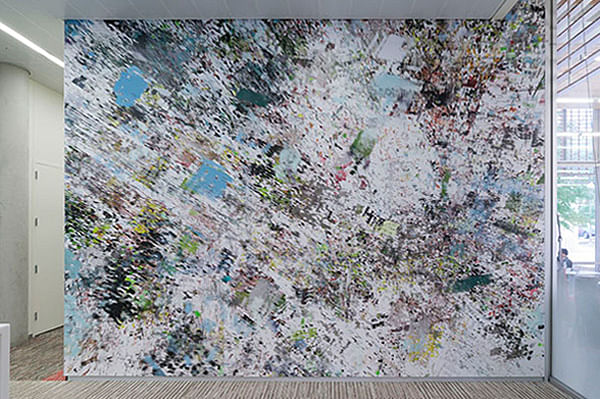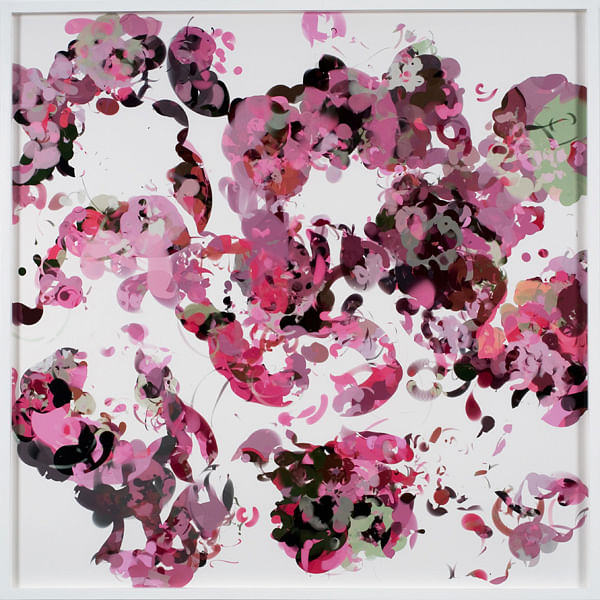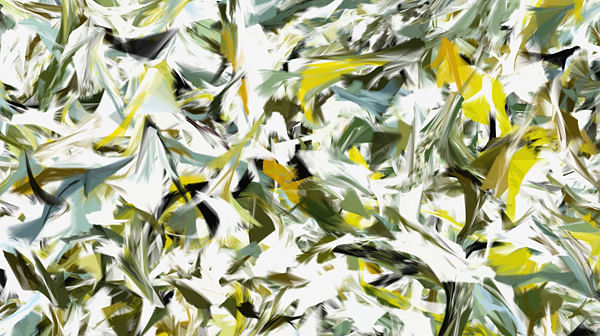

ACADIA 2014 was labeled as a conference focused on Architectural Design Agency and Authorship, yet of course it seemed only fitting that it would close out with a keynote by Casey Reas. Art, the word that an architect cringes at. A word that can resonate more as a critique than a compliment. One that signifies the ripping from architectural ideals, even if such ideals are still up for debate.
Effortlessly combining qualities such as computer processing, ephemerality, and aesthetics, Reas' work allows for the beauty of generative creation to shatter previously held biases. In his work, the computer ceases to feel cold and detached. Used as systems of execution and stability, computers are rarely seen as systems of self-evolution, discovery and beauty. We expect a result, and in that expectation is where the work presented took hold. An artist by trade, Casey has made exponential impacts on architecture and the creative industry as a whole. As a co-creator of Processing with Ben Fry, Casey's work justifies ACADIA's existence. It would be hard, even impossible, to imagine even a percentage of the projects being here today if it were not for the realm of possibilities that Casey has helped bring to fruition.
As architects, designers and human beings we look for beauty. We seek it out and yet when the responsibility to make something beautiful comes along we freeze.Computers are so easily seen as insane, at least by Einstein's definition: "doing the same thing over and over again and expecting different results". They are systems, results are assured, expected and demanded. That ability for “thought” to take hold, that endless computation will materialize into visual performance, is where Casey’s work resides. He more closely asks a question, one that he “feels” has qualities and inklings that will reveal a twist. He allows his art to speak, for the computer to answer, and for the medium to become part and equal partner in the discovery. Allowing this concentration and obsession to motivate him through his craft, his resilience shines through the process.

A turning point in the conference as a whole came in the form of a question from an audience member: “How do you know when to stop the Processing process? ... I mean, does the choice of hitting stop really get down to your sense of aesthetics, is it that simple?”
If we turn to the computer to answer impossible questions, then we are programming our obsolescence.“Yes, yes it is”, Casey answered. With that, he silenced the crowd. The was question that everyone was wondering all conference long. Objects seemed to be interesting, or significant because of their process. We were made promises of beauty, utility and optimization but no one dared to say beautiful. As architects, designers and human beings we look for beauty. We seek it out, and yet when the responsibility to make something beautiful comes along, we freeze. We rationalize and control. Yet Casey, someone who has pushed forward the digital, mathematical and processing world to new lengths, still uses his intuition for beauty, for aesthetics. In that one moment the elephant in the room was addressed. We can't solely rely on the computer to give us answers, but as designers we must know when to hit stop, peel away and see the beauty, address it with the same critical eye that we view a painting, a drawing, or a building. If we turn to the computer to answer impossible questions, then we are programming our obsolescence.
The audience took a breath of fresh air, an ability to enjoy the work, to smile and not become architects. He made us patrons. He allowed us to watch the Processing on the screen and see optimism and beauty on each slide. There was no wondering what was next, no questioning where the work was headed, no thoughts beyond wanting more.

Casey began his lecture by addressing the four main themes that would resonate through the presentation: his studio work, his teaching, expanding Processing and academic writing. These four worlds is where Casey exist, all equally dominant. A key distinction for Casey in all these themes is how to use software in two modes: one where the user uses, the other where the user creates. Creation is where thoughts are turned to sketching – this is where the power of computing becomes clear. To not think of the computer as a finalizer but as pencil and paper, open to sketches and intentionally rough ideas.
Then, at the whim and urge of the program itself, it would be erased, only to be replaced by another unforgettable visual.Process Compendium, one of Reas’ series, proved to be the most breathtaking. The compositions that were created brought to mind master painters. The colors, the spatial qualities, all of the pieces evoked reaction. The work was centered on agent systems, ones that could continue ad infinitum; yet in these paused moments we sense the vastness of the work. There is no sensation of stiffness in the prints; in fact they felt more akin to strips of film spliced together to reveal a story, but not its direction nor speed. If Jackson Pollock could see the work, his mouth would drop to the floor. It would be as if you were able to grab every moment, every level of ink leaving a brush. Palimpsest upon palimpsest appeared, implanting its memory firmly in the viewer’s mind. Then, at the whim and urge of the program itself, it would be erased, only to be replaced by another unforgettable visual.
Reas is clearly a creator, and can jump through the system with virtuosity. He never thinks of it as an addition or choice; he can simply feel his way through the creation. His current sketches have a clarity of idea that was hard to come by in the earlier days. He felt comfortable with allowing space for the work to grow, to expand through his guidance, even allowing certain levels of indeterminacy to find its way through explorations.

To a point. To an artist, the mediums become tools of deployment. As the computer has become Reas’ means and ends, he showed how many other mediums find there way into his world. His “A Mathematical Theory of Communication” deals with scale and micro-composition, to study spatial connection through graphics and color. “Chronograph”, located on-site in Miami, Florida, splices together photography into a dance quartet of beams and construction.
While generative software remains his main focus and most viewed delivery of ideas, he’s also produced work in prints, static objects, installations, and others. So, here, where does the art lie, in the product that gets revealed? In the process it was created? Or in the mind that allowed itself to think it could be created? For Casey, it doesn’t matter, as long as it keeps going.
What is admirable about the fantastic is that there is no longer anything fantastic: there is only the real.” ― André Breton
Anthony Morey is a Los Angeles based designer, curator, educator, and lecturer of experimental methods of art, design and architectural biases. Morey concentrates in the formulation and fostering of new modes of disciplinary engagement, public dissemination, and cultural cultivation. Morey is the ...
5 Comments
Agree
Ever changing and evolving art. Sounds cool but not sure it's much more than a gimick.
Thayer, come on...if that is a gimmick than that scraping of the paintings Gerhard Richter does is a gimmick....and we both know that is not the case (good documentary on Netflix on Richter) love his work, especially how it evolved and changed over time.
The work is very interesting and even beautiful from what I see in these shots. It's the whole fetishizing the "process" that sounds a bit trite. "Then, at the whim and urge of the program itself, it would be erased, only to be replaced by another unforgettable visual." Unforgettable, until it is. As if a "program" had instinct.
The video was kind of like watching the grass grow. Plus or minus some swishes, not much to hold ones' attention, but I can see this being very interesting for those immersed in the virtual. Maybe it's the words that make it feel gimmicky but still, he has an eye, if in fact it's him and not the computer!
i agree on "process", although i've come around over the years on "process", I still do not like the fetishizing of it.
was sitting in a meeting with a potential client in her living room, as she took a phone call I glanced over at a stack of books next to paintings - I saw a book titled "Artist Techniques and Materials".
for a brief second I thought, man that is what it's about - materials and technique.
the virtual here has to be viewed as "the mind" or an extension thereof, the "computer", as the "material". It's weird to make the mind a "material" but I think we are getting there - virtually.
Block this user
Are you sure you want to block this user and hide all related comments throughout the site?
Archinect
This is your first comment on Archinect. Your comment will be visible once approved.